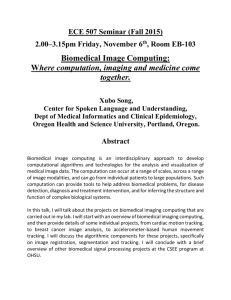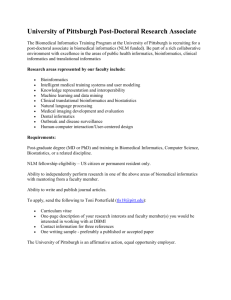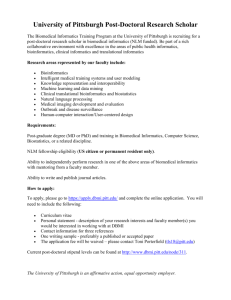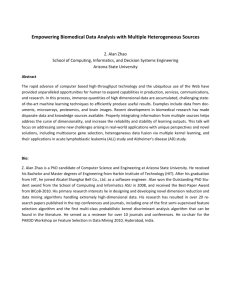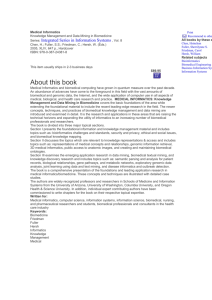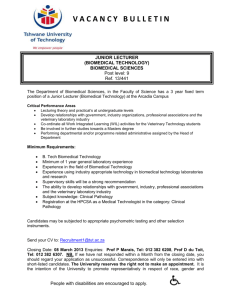introduction
advertisement
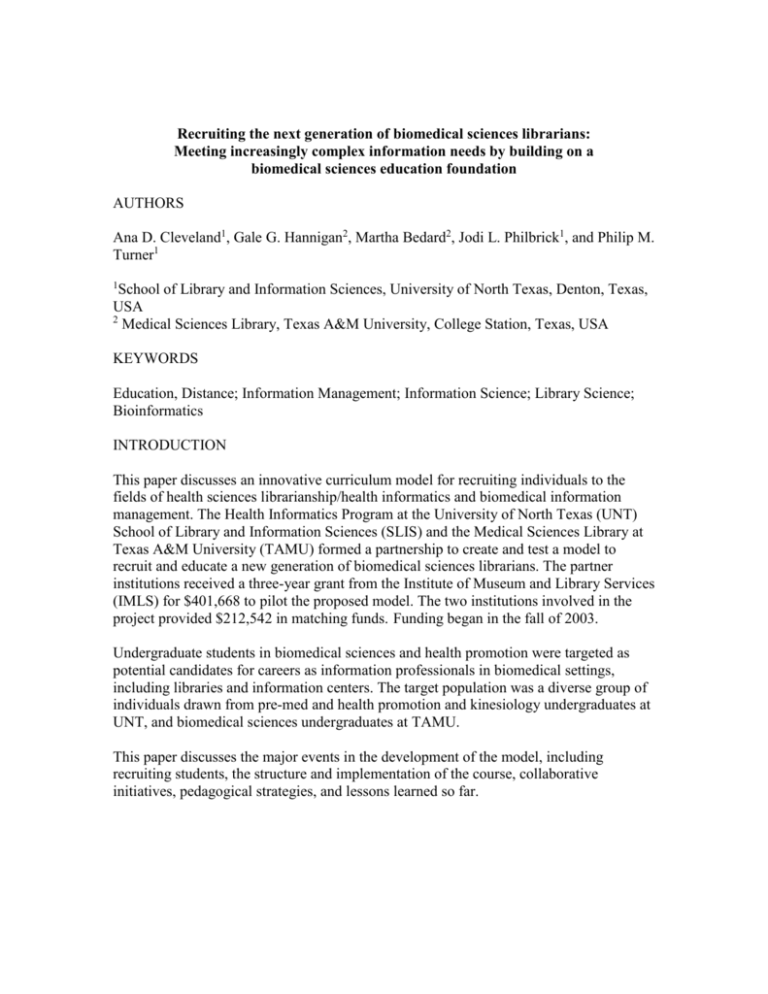
Recruiting the next generation of biomedical sciences librarians: Meeting increasingly complex information needs by building on a biomedical sciences education foundation AUTHORS Ana D. Cleveland1, Gale G. Hannigan2, Martha Bedard2, Jodi L. Philbrick1, and Philip M. Turner1 1 School of Library and Information Sciences, University of North Texas, Denton, Texas, USA 2 Medical Sciences Library, Texas A&M University, College Station, Texas, USA KEYWORDS Education, Distance; Information Management; Information Science; Library Science; Bioinformatics INTRODUCTION This paper discusses an innovative curriculum model for recruiting individuals to the fields of health sciences librarianship/health informatics and biomedical information management. The Health Informatics Program at the University of North Texas (UNT) School of Library and Information Sciences (SLIS) and the Medical Sciences Library at Texas A&M University (TAMU) formed a partnership to create and test a model to recruit and educate a new generation of biomedical sciences librarians. The partner institutions received a three-year grant from the Institute of Museum and Library Services (IMLS) for $401,668 to pilot the proposed model. The two institutions involved in the project provided $212,542 in matching funds. Funding began in the fall of 2003. Undergraduate students in biomedical sciences and health promotion were targeted as potential candidates for careers as information professionals in biomedical settings, including libraries and information centers. The target population was a diverse group of individuals drawn from pre-med and health promotion and kinesiology undergraduates at UNT, and biomedical sciences undergraduates at TAMU. This paper discusses the major events in the development of the model, including recruiting students, the structure and implementation of the course, collaborative initiatives, pedagogical strategies, and lessons learned so far. BACKGROUND AND NEED Every profession needs to recruit new individuals to ensure that the profession remains viable, which is especially important in newly developing fields. Biomedical sciences information management is a growing, dynamic field, and recruitment is a top priority. Both the Medical Library Association’s report from the Task Force to Plan Recruitment of the 21st Century Workforce of Health Information Professionals and the American Library Association have stated that the current librarian workforce is rapidly approaching retirement age, and this is one of the most critical issues in the profession. Equally important is the need to look beyond traditional recruiting methods to attract a new type of recruit due to the changing nature of the health information profession field. New knowledge domains and skills are increasingly important. Research and practice depend on the ability to collect, organize, evaluate, interpret and communicate information. The increasingly complex nature of biomedical information and the rapid development and change in information technology require information specialists to have subject knowledge and education in the biomedical and health sciences. Lynch (1999), Luscombe et al (2001), and Maojo et al (2003) have discussed the inter-relation of bioinformatics with medical libraries and medical informatics. The trend toward interdisciplinary interaction in health sciences and information sciences is evident. Professionals in health sciences librarianship, health informatics, and bioinformatics are discovering their common ground. Miller (2000) discussed how “bioinformatics researchers can benefit from techniques and approaches that informaticians have used” (p. 434), and two examples he provided were data mining and knowledge representation. MacMullen and Denn (2005) pointed out that the bioinformatics “area depends to some extent on the results of research into information seeking and use behavior by molecular biologists. Because there are so many publicly available data sources and analysis options, there is a great need for library and other information intermediary services to help molecular biologists navigate to the information they need” (p. 453). Later they wrote, “Although some of the domain-specific issues are unique, many of the broad challenges reflect problems the information and library science community has been a leader in addressing for decades. We believe that ILS has unique approaches to these problems that could provide significant value to molecular biology...” (p. 454). Larsen (2005) reminded us of the essential linking of information and knowledge to any area of research in the life sciences. He wrote, “Without an effective information management strategy, there is little point in doing biological research” (p. 32). He made the point that there is a need for context integration: The amount of information available to a life sciences researcher is extremely large, dynamic, and rapidly growing. The scientific literature alone is expanding at an astronomical rate, and advances in high-throughput technologies have significantly increased the amount of information that researchers must assess. They are faced with the daunting challenge of efficiently identifying, managing, and analyzing relevant scientific information from both public and proprietary sources (p. 32). In spring 2005, the Journal of the American Society for Information Science and Technology published a special issue on Bioinformatics. Hemminger (2005), in the introduction to the issue, stated that “the challenges in bioinformatics are similar to the information science challenges posed by most domains: what are the best methods to represent and organize data that facilitates knowledge extraction; how to relate information acquired from many different disciplines; how to search disparate types of information captured from a plethora of heterogeneous resources” (p. 437). As bioinformatics grows and becomes more complex, it becomes even more essential that information professionals be closely attuned to the specifics of the subjects that they deal with. This project puts this issue at the forefront of the effort to recruit information professionals. PROJECT PARTNERS The project partners include TAMU Medical Sciences Library and the UNT-SLIS Health Informatics Program, in collaboration with the UNT undergraduate pre-med and Health Promotion and Kinesiology programs and the undergraduate Biomedical Sciences and Health and Kinesiology departments at TAMU. The project is led by Martha Bedard, Ana Cleveland, Gale Hannigan, and Philip Turner. M. Bedard is Director of the TAMU Medical Sciences Library and Associate Director for TAMU Libraries. She serves on the SLIS Board of Advisors and is a regular guest speaker in the Health Informatics Program. G. Hannigan is Director of Informatics for Medical Education at the TAMU Medical College of Medicine. Also, she is adjunct professor in the UNT Health Informatics Program. TAMU brings to the project outstanding resources, including faculty and library resources pertinent to the project. A. Cleveland is the Director of the Health Informatics Program at the UNT School of Library and Information Sciences. This program has an international reputation for quality and innovation, in particular in its pioneering work in developing online curricula. At the time of the grant award, P. Turner was the dean of SLIS. Presently, he is the ViceProvost for Enhanced Learning. Cooperation between the two institutions goes back a number of years. G. Hannigan has taught courses for the UNT program and A. Cleveland has placed many health informatics interns in the TAMU Medical Sciences Library. Also, TAMU libraries employ a number of UNT SLIS graduates. MODEL In the library profession, the traditional recruiting model has been general and aimed at a broad spectrum of students. This model has not been very effective attracting many candidates with science backgrounds or with biomedical subject knowledge. The premise of the new model is that a new approach to recruiting is needed due to the dynamic changes in the biomedical sciences field, which are altering the nature of the creation and distribution of biomedical information. The new approach is to target specific undergraduate students majoring in biomedical and health sciences, including health promotions that are enrolled in two universities. The goal is to attract individuals with biomedical domain-specific knowledge into the field of library and information science/health informatics. Undergraduate students majoring in specific biomedical and health sciences are an untapped and needed resource. The ultimate outcome desired for the application of the model in this project is the recruitment of first-class undergraduates for the fields of health sciences librarianship, health informatics and biomedical sciences information management. The basic components of the model are: Partnership of a school of library and information sciences and a medical library Partnerships with academic departments in biomedical and health sciences Targeting recruitment to specific domain-based groups Three (3) credit hour upper level course Interdisciplinary instruction Flexible institutional settings Master’s fellowship program Information Advisor On-Call link-to-practice program Evaluation at the different stages of the project For this project, the first component of the model, the partnership between a school of library and information sciences and a medical sciences library evolved from the collaborative efforts already in place between both institutions. It was a natural progression due to the awareness of the current environment of biomedical sciences and the education of biomedical health information professionals. The academic undergraduate departments (biology, health promotion, biomedical sciences) were selected to join the project partnership on the basis of their appropriateness to the objectives of the project and on previous professional collaborative efforts. The new model is designed to encourage students with biomedical and health sciences subject backgrounds and interests to enter schools of library and information sciences by the following methods: approaching them with an innovative course in their undergraduate program; by direct mentoring; by presenting career options in biomedical information management and health sciences librarianship/health informatics; and finally, the enticement of financial support with fellowships. The instructional component of the model focuses on the design and delivery of an undergraduate course in biomedical sciences information management. The content of the course was divided into four major areas: Biomedical information in the information age including ethical, legal and societal issues Principles of information organization including the biomedical literature and its characteristics Information retrieval including literature databases, hazardous substances and gene information databases and consumer health databases Applications of biomedical information management including career opportunities The three credit hour course was organized into 14 weeks. It was designed to be delivered primarily as a web-based course, with three required face-to-face videoconference sessions at the beginning, mid-course, and end of the semester. The videoconference sessions were conducted as symposia and provided an opportunity to bring international and national experts to the class. Each web-based module was designed using a template that included educational objectives, online readings, a faculty overview of the topic in the form of a MS Power Point presentation, exercises, and an optional anonymous evaluation of the module. An additional course requirement was a final project. The management of the course, especially with large enrollment of students, required extensive support from teaching assistants. The teaching faculty consisted of librarians primarily from TAMU and UNT as well as invited biomedical experts. This interdisciplinary approach reflects the evolving trend in biomedical sciences. The model was constructed so that it could be applied in single institutional settings or in multi-institutional settings. The methods and course materials were primarily produced for the Web environment in order to facilitate easy transport across institutional settings. The master’s fellowship program is a component of the School of Library and Information Sciences at UNT. Evidence in the literature documents a strong need for biomedical sciences professionals with skills in information management. A master’s degree in Information Science with an emphasis in Health Informatics offers a solution to the problem. The master’s program at UNT-SLIS will provide the context to test the model for this stage of the project. The program has numerous attractive elements, which provides an excellent ground for success. U.S. News & World Report ranked the Health Sciences Librarianship/Informatics program at SLIS second in the United States. Also, the School of Library and Information Science embraces the interdisciplinary approach in many of its programs. The faculty involve in this project have effectively worked together in many academic endeavors to educate health informatics and library sciences students. Another curricular component of the model is the Information Advisor On-Call program which will pair fellows with graduate health students and bioinformatics professionals and provide the fellows with the skills and resources to support clinical practice, information discovery, retrieval, and instruction. Evaluation is incorporated at the different stages of the project. A number of indicators will be assessed including: Number of students enrolled in the course Success in integrating courses into departmental curricula Student class evaluations Number of students applying for fellowships at UNT SLIS Interviews of students who opt to attend schools of library and information sciences Follow up with fellows actively employed as health library professionals or in bioinformatics settings for a five year period Survey and interviews with the faculty participants in the project Overall, the effort of the project in recruiting, teaching, and mentoring was to develop a model based on interdisciplinary and inter-institutional partnership. IMPLEMENTING THE UNDERGRADUATE PHASE OF THE PROJECT Planning and Designing the Course Planning and designing of the course was a team effort. In the spring 2004, the team began by conducting a comprehensive search of existing related courses in bioinformatics and biomedical information management. The content of these courses served as the baseline for planning the new course. Essential goals were to construct the course for a WebCT platform delivery and the need to customize course content toward undergraduate students majoring in biomedical or health sciences. Primary course instructors (Hannigan and Cleveland) already had extensive experience using WebCT. Biomedical experts were sent a detailed outline of the course and were asked to critique it and make suggestions. Once the course outline was finalized the details of the course were addressed, including lectures, readings, and assignments. Deploying the Course During the academic year 2004-2005, the course was taught under the title “Biomedical Sciences Information Management.” At TAMU, the course was delivered under BIMS 489 and at UNT under BIOL 4005 and HLTH 4900. The students were juniors and seniors, and many were still deciding on the career path they were going to take. Career interests included medicine, dentistry, veterinary medicine, pharmacy, forensics, health promotion, health education, personal training, research, and more. In the fall 2004 semester, 42 students enrolled in the course, and in the spring 2005, 67 enrolled. A total of 97 students completed the course. The course was offered simultaneously to both UNT and TAMU students through web-based instructional technology and three face-to-face videoconference meetings. Chat sessions and discussion lists were utilized to discuss and complete assignments. Information specialists were consulted to develop and design course modules. Each semester a symposium was offered focusing on topics related to the course content and career options in health sciences librarianship, health informatics and bioinformatics. Internationally known experts were invited presenters. For example, Michael Ackerman from the Lister Hill National Center for Biomedical Communication, US National Library of Medicine, presented an overview of the Visible Human Project. Duane Kramer, TAMU, Professor, Veterinary Physiology and Pharmacology talked about the “Role of Information in Cloning Animals” and Robert Benjamin, UNT, Professor of Forensic Biology discussed “Forensic Medicine: Information Dependent.” Publicizing the Course From the beginning, the project directors understood that a critical key to success was effectively marketing the project and the course. Publicity for the course was distributed with collaboration of the academic undergraduate advisors in the partnership. The following efforts were initiated: A flyer was developed titled “Become a Bio Info Pro!” featuring the reasons for enrolling in a new and exciting course aimed preparing students in areas of biomedical sciences information management A fact sheet, with specific information about the program, was distributed to biomedical, health promotion, and health sciences advisors at both the TAMU and the UNT campuses Public relations statement for institutional release were written and distributed Recruitment and Enrollment of the Students The project faculty recognized that it was essential to engage the undergraduate advisors from the partnership units in recruiting for the course. The course description and the course outline were sent in print and electronic formats to the undergraduate advisors in biomedical sciences at TAMU and to the biology, health promotion advisors at UNT. Having a solid marketing plan was the essential element that resulted in higher enrollment that expected. By the time the advising process began for the spring 2005, the undergraduate advisors had received positive feedback on the course and there was a dramatic increase in enrollment in the class. IMPLEMENTING THE MASTER’S PHASE OF THE PROJECT Selecting Fellows The project is funded for 10 fellowships to the master’s program at UNT-SLIS. The fellows will need to meet the general criteria for admittance to the Toulouse School of Graduate Studies at UNT and the specific entrance criteria of SLIS. Fellowships applicants must have an undergraduate degree in biomedical sciences or health promotion. For awarding a fellowship, weight will be given to student performance in the undergraduate course, Biomedical Sciences Information Management, and to evaluations from faculty familiar with the student’s background and past performance. Developing a Model Degree Plan The project directors are in the process of developing the fellowship degree plan. The fellows must take two four-hour core courses required of all masters student in SLIS programs and a one credit hour introductory course in library and information sciences. Six graduate credit hours of electives outside SLIS are required in the areas of biomedical sciences or/and health promotion. Beyond this, the course choices are flexible in order to meet career goals of the fellows. In general, the degree plan will follow the successful Health Informatics Program of Study. Mentoring the Fellows through the Program One of the requirements at UNT-SLIS for a master’s degree in information science with the specialization in health informatics is that students complete an internship in a healthrelated environment. Since 1988, SLIS has had a tradition of placing health informatics interns in traditional locations such as hospital libraries, academic health sciences libraries as well as in non-traditional locations such as medical school departments (i.e. Dept. of Family Medicine), a School of Public Health, practice settings, (i.e. doctor’s office) among others. The purpose of these internships and, in particular, in the latter settings is the need to understand the culture and the information needs of the clientele that they intend to serve. There is evidence that this approach to the internships has lead to desirable outcomes by the fact that placement of the graduates of the Health Informatics Program at SLIS has been excellent. Davidoff and Florance (2000) recommended that an information specialist, whom they call the informationist, be part of a health care team supporting the information needs of the group. In this project, The Information Advisor-on-Call internship provides the fellows the opportunity to experience information need in the context of the practice setting where they are completing their internship. As Florance, Guise and Ketchell (2002) stated, “The point is that an information need (the problem) cannot be divorced from its context” (p.50). Institutional participation in the Information Advisor On-Call program will be primarily based at the University of North Texas Health Science Center at Fort Worth, School of Public Health, UNT Health and Wellness Center, and the Department of Family Medicine. In addition, TAMU School of Rural Public Health, the College of Medicine, and the College of Veterinary Medicine may be included in the program. Other programs throughout the state are possible partners depending on the needs of individual fellows. ISSUES AND CHALLENGES There are a number of issues and challenges that became apparent during the implementation of this project. Lessons learned were related to collaborative efforts, institutional support, pedagogical methods, course management, and technology support. Some of them had to do with: Working with undergraduate advisors Faculty with experience in teaching graduate students only Electronic reserves between both universities Videoconference sessions at both institutions (scheduling, facilities, support) Grading Level of staff to support course management Logistics of the symposium Course revenues SUMMARY The goal of the project was to test a recruiting model that focused on undergraduate students in the biomedical and health sciences. A future goal will be to test the model with other subject domains. That is, can it work with any desired recruiting subject knowledge group? Currently, we are in the second year of a three-year-grant from the Institute of Museum and Library Services. At this point all of the grant objectives are being met, and the project team, along with members of the partnership, is pleased with the achieved results. Experience from the previous academic year makes it feasible to develop a model curriculum. The course’s structure and content have proven successful. The delivery of the undergraduate class was well received by the students and the participating departments. There are strong benefits from teaching the undergraduate course as collaboration between a school of library and information sciences and a medical sciences library. The students’ experience becomes much more valuable by utilizing the strength of both institutions in tandem. The recruitment for fellows in the Master’s program in library and information sciences is underway. There are indications from the TAMU Medical Sciences Library and from the UNT School of Library and Information Sciences that if the outcomes are positive for this pilot project, the Biomedical Sciences Information Management course will be sustained by both of the universities. REFERENCES American Library Association [homepage on the Internet]. Chicago: American Library Association; c2005 [updated 2002 Jan 1; cited 2005 Aug 2]. Need for Librarians on the Rise; [about 3 screens]. Available from: http://www.ala.org/ala/pio/piopresskits/recruitpresskit/Needforlibrarians.htm Davidoff F, Florance V. The informationist: A new health profession? Ann Intern Med. 2000;132(2):96-8. Florance V, Guise NB, Ketchell DS. Information in context: Integrating information specialists into practice settings. J Med Libr Assoc. 2002; 90(1):49-58. Hemminger BM. Introduction to the special issue on bioinformatcs. J Am Soc Inf Sci. Tech. 2005;56(5):437-9. Larsen C. Knowledge Management Strategies for Biologics Research. Biopharm Int. Duluth. 2005;18(5):32-8. Luscombe NM, Greenbaum D, Gerstein M. What is bioinformatics? A proposed definition and overview of the field. Methods Inf Med. 2001;40: 346-58. Lynch C. Medical libraries, bioinformatics, and networked information: a coming convergence. Bull Med Libr Assoc. 1999;87(4):408-14. Medical Library Association [homepage on the Internet]. Chicago: Medical Library Association; c1999-2005 [cited 2005 Aug 2]. Task Force to Plan Recruitment of the 21st Century Workforce of Health Information Professionals. Available from: http://www.mlanet.org/about/planning/recruit_draft_plan_20020918.doc Maojo V, Kulikowski CABioinformatics and medical informatics: Collaborations on the road to genomic medicine? J Am Med Inform Assoc. Nov/Dec 2003;0(6):515-22. MacMullen WJ, Denn SO. Information problems in molecular biology and bioinformatics. J Am Soc Infor Sci Tech. 2005;56(5): 447-56. Miller PL. Opportunities at the intersection of bioinformatics and health informatics: a case study. J Am Med Inform Assoc. 2000;7(5): 431-8. U.S. News & World Report [homepage on the Internet]. Washington: U.S. News & World Report; c2005 [cited 2005 August 4]. Library Science Specialities: Health Librarianship; [about 2 screens]. Available from: http://www.usnews.com/usnews/edu/grad/rankings/lib/brief/libsp2_brief.php.
